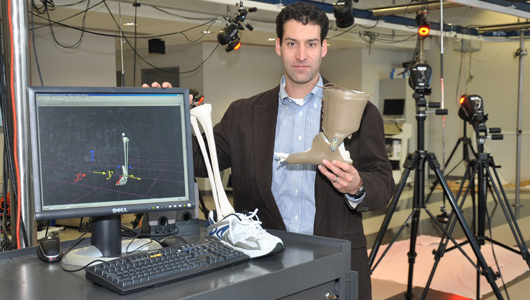Upstate study to help determine treatment for common foot disorder
SYRACUSE, N.Y.-- Adults aged 40 and older with flatfoot due to Posterior Tibial Tendon Dysfunction (PTTD) may be eligible to participate in an Upstate Medical University clinical trial to help determine the most appropriate, conservative treatment for PTTD.
Upstate is recruiting patients for this four-year study that is funded by the National Institutes of Health. Christopher Neville P.T., Ph.D., is leading Upstate’s participation in the study -Effect of Posterior Tibial Tendon Dysfunction Specific Braces on Foot Kinematics in subjects with stage II Posterior Tibial Tendon Dysfunction (PTTD). Neville is associate professor of physical therapy at Upstate’s College of Health Professions.
The trial will test various ankle braces currently used to treat PTTD. Study findings will determine which brace design is most successful to use clinically and will provide insight for future device development. Devices used in the study are all FDA-approved standard ankle braces that are currently available to the general public and commonly used to treat flat feet.
“Ankle braces serve as essential elements of conservative care programs for PTTD,” said Neville, “and data on currently used braces remains limited.” Neville adds that current brace designs focus on correcting the flatfoot kinematics in people with stage II PTTD.
“However, designs that limit motion may lead to weakness and altered gait dynamics,” he said. “It remains unclear if alternative designs could be more optimal for people with PTTD,” he said.
Study participants will be asked to attend testing sessions at the Motion Analysis Laboratory at the Institute for Human Performance on Irving Avenue in Syracuse. The visits can be scheduled at the convenience of the participant. Each participant will then be followed for 12 weeks while wearing one of the ankle braces. Clinical outcomes including strength, tendon morphology, and self reported outcomes will be measured at 12 weeks.
PTTD is one of the most common problems of the foot and ankle, more common in women and in people older than 40 years of age, says the American Academy of Orthopaedic Surgeons. It occurs when the posterior tibial tendon becomes inflamed or torn. As a result the tendon may not be able to provide stability and support for the arch of the foot, resulting in flatfoot. An acute injury, such as from a fall, or overuse, can tear the posterior tibial tendon or cause it to become inflamed. Additional risk factors include obesity, diabetes and hypertension.
For more information about the study, call Upstate’s Motion Analysis Laboratory at 315-464-9966 or email [email protected].
Caption: Christopher Neville PT, PhD, is leading Upstate’s participation in the study that will help determine the most appropriate, conservative treatment for PTTD.





